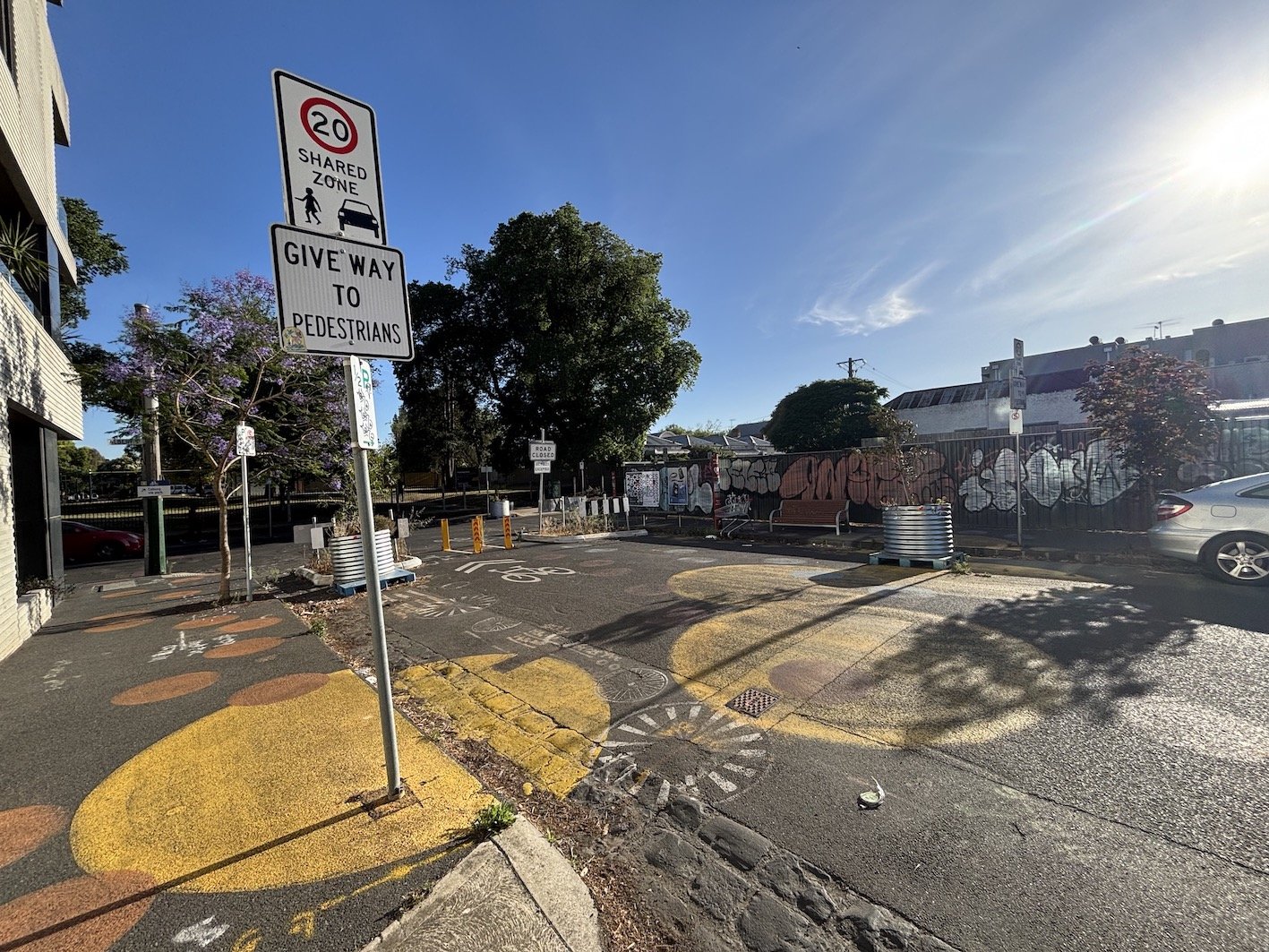
Share the Street
Who is the Street for? Designing Streets That Connect Pedestrians Communities
What’s it about?
A Shared Street or Shared Zone is where pedestrians, cyclists and motorised traffic share the same road space
Shared streets (sometimes called living streets) are intentionally designed to prioritise the needs of pedestrians and cyclists over motorists, creating flexible spaces that accommodate various street users [1]. While motor vehicles are allowed in shared spaces, they are often visually designed to give equal priority of use to pedestrians, cyclists and motorists alike.
Special rules and speed limits apply for shared zones. They are typically differentiated by different surface treatments like textured pavements, road makings and signage as well as physical separation such as bollards [2].
In some areas the maximum speed limit is as low as 10 km/h [2]. Other areas don’t enforce a speed limit, but the visual cues of the shared streets encourage traffic to slow down around pedestrians.
Merri-Bek Council’s Temporary Shared Street in Brunswick East, Melbourne
Watch
Safer Streets in 100 Seconds or Less
Intersection Design Guide
What we can learn about intersection safety from this Melbourne Example
Roundabouts
Everything we love about roundabouts and why.
30km /hr Speed Limits
Some Councils are introducing slower speeds, and the benefits are unexpected.
Benefits
Who Benefits from Shared Streets?
Improved Safety for Motorists and Pedestrians
Shared streets reduce traffic speeds and enhance awareness, significantly lowering the risk of accidents. With all users sharing the same space, motorists are more cautious, and pedestrians enjoy safer conditions.
Local Economy
Shared streets can add benefits to local traders, as slower traffic means higher density of pedestrians and visitors, as well are creating environments where street trading - such as cafes having tables and chairs on pavement - is safer and more inviting because of slower traffic.
Vibrant Public Spaces
By prioritising pedestrian movement and interaction, shared streets transform urban areas into dynamic public spaces. They promote social engagement, support local businesses, and enhance the aesthetic appeal of neighborhoods, boosting community well-being and economic vibrancy.
Accessible Spaces
Shared streets cater to diverse users and vulnerable road users, including children, the elderly, and those with disabilities. They typically include a change in pavement texture such as tactile paving, and seating areas ensure inclusivity, making these streets navigable and enjoyable for everyone.
Shared Street Examples
There are a range of different types of shared streets for different types of road spaces and uses.
Commercial Shared Streets
These streets prioritise pedestrian-friendly environments in busy urban centers, supporting local businesses and encouraging economic growth.
An example is Brisbane’s Albert Street Shared Zone, located adjacent to entrances to King George Square Bus Station and King George Square Cycle Centre. This street maintains one-way access for service vehicles and access to the adjacent Albert Street Uniting Church. Traffic calming measures and landscaping prioritise pedestrian experience in the area.
Brisbane’s Albert Street is a Shared Zone
Residential Shared Streets
Residential Shared Streets are often characterised by textured or coloured pavements that prioritise pedestrian movement by looking less like a ‘road’, although vehicle access to residences is often still permitted.
Speed limits are also often lower, and in the case of NSW, mandated at 10km / hr [2].
An example is Alliot Mews, Edmondson Park between Farrell Street and Oxley Street in Sydney where planting and textured pavement slow traffic and encourage increased cycling and walking.
Alliot Mews Residential Shared Street, Edmondson Park, Sydney
Event-Ready and Temporary Shared Streets
Streets can be adapted to shared streets for cultural events, markets, or temporary closures. NSW Streets as Public Spaces has encouraged the temporary closure of streets to facilitate events and pop up public spaces.
In the City of Melbourne, bollards are used to create temporary shared streets. At busy pedestrian times such as lunchtime, vehicles are prevented from entering selected laneways, creating a pedestrian zone. In this example the road is shared by enabled consecutive (rather than concurrent) sharing of the roadway.
Melbourne’s Merri-Bek Council has also adopted a temporary approach, using simple paint patterns and planters to test the response to the shared street.
Merri-Bek Council’s Temporary Shared Street in Brunswick East, Melbourne
Play Streets
Play streets are the temporary creation of shared streets to facilitate street play, and are a form of shared street. This may be for an afternoon or weekend. Play streets often have limited vehicle access and use temporary bollards or other demarcations to reduce traffic, opening up the road space for play and community uses.
A temporary Play Street in North Melbourne, facilitated by CoDesign Studio
Helpful Guides
Global Street Design Guide, Shared Streets
1000 Play Streets Program, Play Australia
Streets as Shared Spaces Guide, Transport NSW
References
[1] Global Street Design Guide, ‘Shared Streets’ Global Designing Cities Institute.
[2] Transport Standards NSW ‘Technical Direction Traffic management and road safety practice, Design and implementation of shared zones including provision for parking, TTD 2016/001’ February 2016





